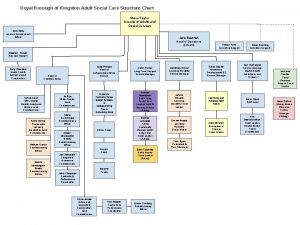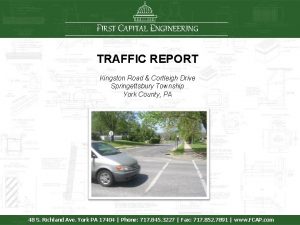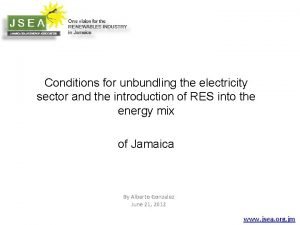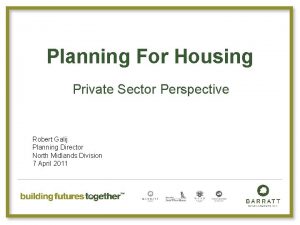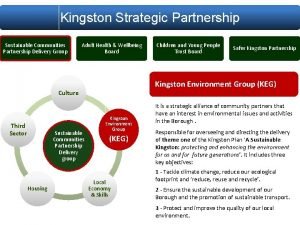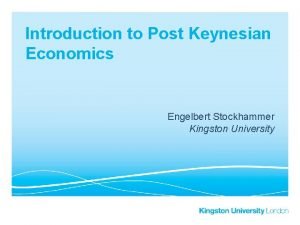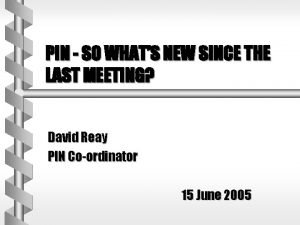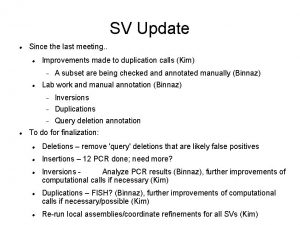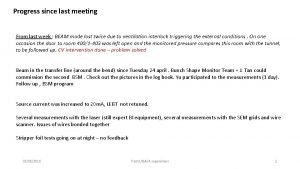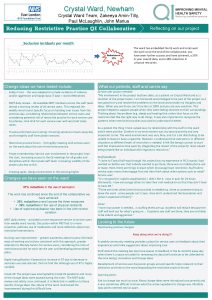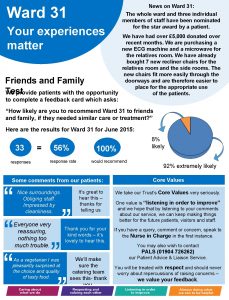Central Ward Meeting Kingston Planning our Future Thursday



























- Slides: 27

Central Ward Meeting Kingston – Planning our Future Thursday 26 October 2017

Welcome • Cr Rosemary West

Ground rules Be respectful Be constructive One person speaks at a time Treat each other as you want to be treated Listen to other people’s ideas Remember this is a big group

Agenda • Welcome and housekeeping. • Presentation (15 minutes) – To provide you with some context of the planning issues facing the municipality. • Two table discussions (45 mins) – To get your feedback about your experience of living or working in Kingston, your wants, experiences and aspirations. • Reporting back (30 minutes) • Next steps (5 minutes) – Outline ways to stay involved in the projects. • Thank you!

Presentation Planning issues and influences facing the City of Kingston

Lisa Riddle – Ethos Urban • Director of Ethos Urban, (previously Planisphere) • Previous work in Kingston • Special expertise in Housing Strategies and Neighbourhood Character studies: – Whitehorse – Banyule – Frankston – Bayside – Glen Eira – Many more!

PLAN MELBOURNE VISION Melbourne will continue to be a global city of opportunity and choice

“ 20 minute neighbourhood”

Kingston - What’s changing • Current population 159, 000 • Change 2011 – 2016 – 10, 719 more people – 4, 011 more dwellings – Decrease of 7. 3% in detached dwellings – Increase of 7. 1% in medium and higher density dwellings • Forecast change 2016 - 2036 – Additional 26, 191 people – 13, 409 more dwellings – Couples with children decreasing, lone person households increasing

Kingston – Managing the change Council needs to think about: • Where to direct housing growth • How to guide the style / form of development • How to encourage jobs • How to manage the additional traffic and parking demands • What additional services will be needed and where • How to protect the environment • What to advocate for from State government

Council’s planning scheme tools • Planning policies and strategies • Apply zones and overlays to direct where specific uses and development are to occur • All changes require State Government approval

Kingston – Planning Our Future Three current projects: • Planning Scheme Review (all encompassing) • Housing Strategy and Neighbourhood Character Study • Car Parking Strategy

Planning Scheme Review • Council required to review Planning Scheme every 4 years • Opportunity to address any gaps or remove redundant policy • Covering a broad range of themes including: – Environment – Housing and built form/ character – Economic development – Social and community infrastructure – Transport and access

Housing Strategy and Neighbourhood Character Study Why do it? • New residential zones introduced and recent changes • Current policy is old and becoming ineffective • Detailed guidelines / controls can be applied • Thorough strategic analysis, with community input, needed to justify controls

What is Neighbourhood Character? “Interplay between built form and landscape in public and private realms. ” • All areas have character • Not all areas have special character • Different elements are important in each area • Some require special controls, others do not • Relationship with Housing Strategy is critical: • Special areas not suitable for growth • Areas for growth not suitable for restrictive controls

Neighbourhood Character is Not. . • A method to limit medium density housing (may be a consequence) • A way to retain individual (old) buildings • A way to limit development to single storey only Neighbourhood character study is: • A way to identify what you care about • A way to enshrine key characteristics in planning law • A way to assist Council in achieving better results

Housing Strategy and Neighbourhood Character Study Outputs: • Neighbourhood Character Study – Statement of preferred character for all residential areas – Identified areas of special character – Built form guidelines • Comprehensive Housing Strategy (20+ years) – Areas for change – Areas for limited change – Recommendations: affordability, env sustainability • Combination of both – Character policy for all areas – New residential zones reflecting housing need

Housing Strategy and Neighbourhood Character Study Process • Stage 1: Issues and Opportunities Analysis - Now Community Consultation - Early 2018 • Stage 2: Preparation of Draft Housing Strategy and Neighbourhood Character Study – Early 2018 Community Consultation - Mid 2018 • Stage 3: Final Strategy and Study – Late 2018 • Stage 4: Planning Scheme Amendment Process – Early 2019 Community Consultation - Mid 2019

Car Parking Strategy • Assess current on and off-street parking to identify areas of surplus or shortfall. • Consider future car parking demand : population forecasts, housing distribution and demographic profiles. • Determine appropriate parking rates for areas across Kingston. • Recommend new parking provision rates for Kingston.

How to have your say Tonight is the start of the conversation: • Please provide your contact details to receive future updates in relation the projects. • Summary of the outcomes of tonight’s meeting will be circulated to all attendees. • All future updates will be available on Council’s website (www. kingston. vic. gov. au)

Discussion #1: What do you value about your street or neighbourhood?

Discussion #2: Table discussion Key themes Theme Examples of these issues? 1. Housing and neighbourhood character Where should more housing be located? Look and feel of your street and neighbourhood? 2. Traffic, transport and parking Where should carparking go? car parking in the street or shopping areas, issues with buses and trains and/or traffic management? 3. Environment, foreshore and heritage How should we protect the environment, trees, water, the beach and/or important heritage buildings? 4. Economic activity, business and employment How to encourage more jobs locally, ideas for small business or ways to create more economic activity? 5. Physical and social infrastructure and services Where and what additional infrastructure or services do you need? Parks, roads, playgrounds, community services, disability services, youth services, older people services?

Activity #2 1. 2. 3. 4. Individually think about your table theme. Collect your thoughts on post-it notes (3 -5 mins individually). Share you thoughts as a group on worksheet #2 (20 minutes). Review the ideas and see if there is a theme of ideas/ priorities for the group or things that were debated. 5. Record top idea at the bottom of the sheet (5 minutes) Task: • When thinking about this topic, I/we think Council should do more…. • When thinking about this topic, I/we think Council should do less….

Ground rules Be respectful Be constructive One person speaks at a time Treat each other as you want to be treated Listen to other peoples ideas Remember this is a big group.

Group feedback and Q &A • Questions about 1. Planning Scheme Review (all encompassing) 2. Housing Strategy and Neighbourhood Character Study 3. Car Parking Strategy • Questions/statements to your Councillors

Next steps Broader conversation about a range of planning issues (tonight) 1. Planning Scheme Review 2. Housing Strategy and Neighbourhood Character Study 3. Car Parking Strategy • Register your interest if you’d like to continue the conversation about any (or all) of the three targeted projects.

Thank you
 Kingston planning scheme
Kingston planning scheme Lingual split bone technique
Lingual split bone technique Our census our future
Our census our future Our census our future
Our census our future Our future is in our hands quotes
Our future is in our hands quotes Future perfect form
Future perfect form Future continuous and future perfect
Future continuous and future perfect Aquajet kingston
Aquajet kingston Adult social care kingston
Adult social care kingston Kingston traffic report
Kingston traffic report Margaret kingston manchester
Margaret kingston manchester Jps ecommerce kingston 5
Jps ecommerce kingston 5 Który hals ma pierwszeństwo
Który hals ma pierwszeństwo On discovery maxine hong kingston
On discovery maxine hong kingston Martin kingston qc
Martin kingston qc Kingston strategic partnership
Kingston strategic partnership Engelbert stockhammer
Engelbert stockhammer Today meeting or today's meeting
Today meeting or today's meeting Proposal kickoff meeting agenda
Proposal kickoff meeting agenda What is meeting and types of meeting
What is meeting and types of meeting Types of meeting
Types of meeting Welcome to our first meeting
Welcome to our first meeting Habr
Habr Www.pinetwork.org
Www.pinetwork.org Welcome to our meeting
Welcome to our meeting Since our last meeting
Since our last meeting Since our last meeting
Since our last meeting Since the last meeting
Since the last meeting








